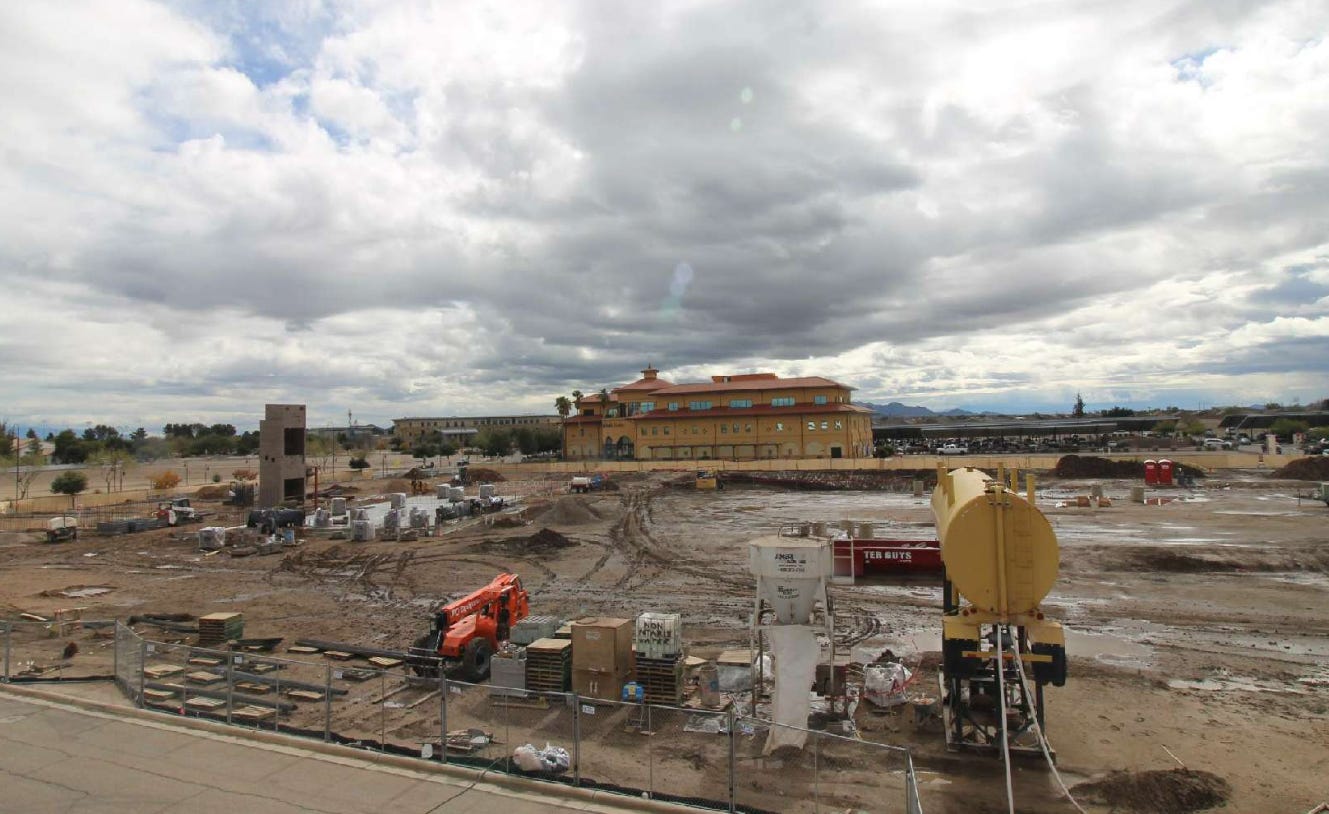The Daily Agenda: News from around the towns
Marana takes on debt for community center ... South Tucson debates RTA projects ... Turn your parents into plant food.
Today, we’re diving into two local government bodies that don’t get a lot of attention, the Marana Town Council and the South Tucson City Council. Our intern Sam Parker checked out their meetings last week to bring you a bit of what they’re up to.
The Marana Town Council voted last week to take on debt to pay for the town’s Community and Aquatic Center. The decision came after the council said sales tax revenue would cover the project’s cost. Town Manager Terry Rozema told Tucson Local Media in October he was glad taxpayers wouldn’t have to borrow the money. The council voted 6-1 at last Tuesday’s meeting to issue bonds to cover the remaining costs, estimated to be $51.5 million. Council member Roxanne Ziegler cast the lone “nay” vote, saying she was alarmed the town’s sales tax revenue wasn’t enough to pay for the facility.
Deputy Town Manager Erik Montague said the bonds are needed because the sales tax revenue, which stands at about $14.5 million so far, would be collected over nine years, while construction would be finished in about a year. Finance Director Yiannis Kalaitzidis praised the debt’s structure, saying the town will hopefully be able to “refinance some older debt, and that through that deal we’re hoping to save about $2 million,” or about $200,000 annually.
Construction of an affordable housing community in Marana has become a point of contention among neighbors who say the construction is a great disturbance. The project in question is the Safford Apartment Complex, which is using land at 8740 N Silverbell Road for 200 apartment homes supported by federal low-income housing tax credits.
Marana residents aired their grievances about the construction during call-to-the-public at last week’s meeting. Katherine Szczygiel, who lives in the Silverbell neighborhood where the complex is being built, told the council that “no one was informed any type of construction would be occurring,” and said the construction noise was “a terrible nightmare.” Montague told the neighbors that town staff had been made aware of these issues, and they met with concerned parties in the council lobby. If construction continues as planned, the complex will be completed in fall 2025.
Tucson Jewish Free Loan, in partnership with Casa Maria Soup Kitchen, is providing loans to low-income South Tucson residents who are at risk of losing their homes. Allison Wexler, executive director of TJFL presented this partnership to the South Tucson City Council last week, telling council members that the work of TJFL was to make interest-free loans of up to $5,000 to help protect people from high-interest credit card debt and predatory loans. Council Member Brian Flagg noted the importance of this mission in the communities of South Tucson, saying “200 places in South Tucson have back taxes, they’re on the chopping block, they have their houses bought out from under them. It’s a county-wide problem…it’s one way that lower-income people are really being screwed.”
The debate over how to balance the varying interests among cities and towns when it comes to Regional Transportation Authority projects raised tensions in the South Tucson City Council chambers last week. The debate revolved around the merits of constructing a business corridor versus increasing investment in public transit and other more localized South Tucson concerns. Flagg even went so far as to question the integrity of the RTA when he remarked that “the inner-city has been disrespected by the RTA for years now.” After much debate, the council passed a motion to communicate support for more local projects catered to the specific needs of South Tucson, rather than larger-scale, multi-jurisdictional projects like the business corridor, which Mayor Paul Diaz advocated for.
The Tucson Agenda is one project we’d really like to see get a lot of support. Help us keep it going with a paid subscription.
Write a letter to the editor (email Curt at curt@tucsonagenda.com). You can reach out to members of the Marana Town Council or the South Tucson City Council.
Expanding early education: More than 1,350 children from low-income homes were able to attend preschool last year, thanks to scholarships through the Pima Early Education Program, the Arizona Republic’s Sarah Lapidus writes. The county has also collaborated with school districts to open 17 new preschool classes funded by scholarships. Supervisors allocated $30 million in federal pandemic funding to pay for three years of the program. Now in its third year, the program will be paid for through a secondary property tax that funds the Library District at the start of year four.
Ashes to ashes, mulch to mulch: Arizona could join seven other states that let residents turn their deceased loved ones into garden mulch, Capitol Media Services’ Howard Fischer reports. A bill in the state House would legalize “natural organic reduction,” which people can put in a flower bed or use to plant a tree. It’s all part of the “circle of life,” like in “The Lion King” movie, as Tucson-area state Rep. Cory McGarr put it.
Battle royale: The race for southern Arizona’s LD17 race is heating up, with a leading social conservative pushing to end a former state senator’s bid to regain his seat, Capitol Media Services’ Fischer reports. Merissa Hamilton is pushing for state Sen. Justine Wadsack to be the Republican nominee this year and has called for former state Sen. Vince Leach to rescind his candidacy. Leach told Fischer he has no intention of dropping out of the race and has a better chance of winning the general election than Wadsack and can raise more money.
Be dazzled: It’s gem show season and with 35 gem and mineral shows popping up around the city, This is Tucson’s Elvia Verdugo has the inside scoop on where to spend your time and money. The three-week event officially kicks off on Saturday and will run through mid-February, although many shows begin before the official launch. Verdugo suggests checking out Visit Tucson’s website for a full listing, but points readers towards five of the biggest and best shows in town.
Bird on the street: For the fourth year in a row, the Sandhill crane population remains higher than the previous five- and 10-year averages, Arizona Public Media’s Summer Hom writes. The Arizona Game and Fish Department estimates that about 42,200 Sandhill cranes are in southeast Arizona this year, with experts speculating that the increased population is due to cranes’ offspring surviving longer.
“Sandhill cranes usually lay about two-to-three eggs," said Game and Fish spokesman Mark Hart. "But only one typically survives. So, the survival rate among those that are born may be higher.”
Bond bucks: Tucson’s largest school district is looking to spend $18.35 million on capital projects in fiscal year 2025, the Arizona Daily Star’s Jessica Votipka writes. The budget was unanimously approved by the Tucson Unified School District’s governing board and includes $7 million in funding for curriculum and instruction. Another $5.63 million has been allocated for technology services and facility improvements will receive $5.4 million in funding. The budget also includes some projects that aren’t covered by TUSD’s $480 million bond approved by voters in November.
56,000: The population of Marana in 2022, according to the U.S. Census Bureau. South Tucson is home to about 4,600 people.












I'm glad to hear that Arizona is considering another option to cremation and burial. The state of Washington is the leader in providing this third option, recompose, in which a dead body is carefully turned into soil. To learn more I highly recommend searching Recompose and its CEO Katrina Spade. About one half of their clients choose to have the soil go to reforestation projects in Washington.
I hope that Arizona follows in their footsteps.